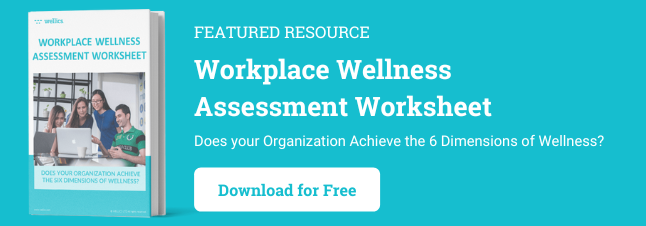Wellness is not just about how far you can run or how well you avoid junk food. Instead, wellness is a multi-dimensional approach to improving quality of life, taking into account a person’s health and well-being across different areas of life.
As more and more organizations look to develop workplace wellness programs as a way to improve productivity, increase employee engagement, and reduce healthcare costs, it’s important to have a meaningful definition of wellness so that managers can design the most effective programs possible.
Our workplace wellness assessment worksheet is designed to help CEOs, Human Resources managers, and other workplace leaders evaluate how well their current employee wellness programs take into account the full definition of wellness, which includes six different dimensions of life.
What Are the Six Dimensions of Wellness?
To get a proper understanding of how healthy your employees are, it’s essential to take a multi-factorial approach.
Wellness consists of six different dimensions that affect us all:
1. Physical: Physical wellness is the dimension of life that represents how energetic and focused someone feels. It also encompasses someone's relative strength, endurance, and mobility. To obtain better physical fitness, we need to exercise, eat a nutrient-rich diet, drink plenty of water, and get sufficient high-quality sleep.
2. Mental: Mental wellness refers to how people cope with life’s challenges. People with high levels of mental wellness are capable of navigating various stressors and changing situations. Staying physically active, cultivating healthy relationships, and finding meaningful work can contribute to better mental well-being.
3. Emotional: Emotional wellness is the measure of how well an individual understands and manages their emotions. Emotionally resilient people are able to express their emotions in a healthy way and are better able to handle confrontation while keeping a positive attitude.
4. Spiritual: Spiritual wellness encompasses a person’s personal belief system or world view. It’s often tied to a person’s sense of personal identity and the meaning they pursue in life. A healthy spiritual life can be cultivated in a variety of ways, including through traditional religious practices, as well as taking time for self-reflection.
5. Social: Social wellness refers to a person’s relationships with others. Whether it’s family, friends, coworkers, or the broader community, people with high social well-being experience an exchange of positive feelings between themselves and those in their lives. In a workplace, social wellness promotes better collaboration and higher productivity.
6. Environmental: Environmental wellness is the quality of the relationship a person has with their surroundings. A high environmental wellness profile might look like a deeper attunement to the bi-directional relationship between personal health and the environment. People may adopt certain lifestyle practices that reflect their awareness of their impact on the environment or to avoid certain health hazards.
What Is a Workplace Wellness Assessment?
To design and implement an effective workplace wellness program, managers must take into account whole-picture wellness. Optimal personal wellness looks like a balance between the six dimensions, with each area being addressed and on the path to fulfillment.
Strategic workplace wellness initiatives provide ways of helping employees evaluate total wellness scores, offering incentives and support to improve areas that are lacking. By reviewing whether your current workplace wellness program addresses all six dimensions of wellness, your organization can be better equipped to make intelligent program improvements that will result in meaningful results in employee well-being.
That’s where an employee wellness assessment comes in. Our workplace wellness worksheet helps managers reflect on and assess the degree to which their organization promotes, supports, monitors, and attempts to improve each dimension of wellness among participating employees.
Using a questionnaire approach that covers different topics under each dimension of wellness, our worksheet can be used as a quarterly or ongoing tool to help those in charge of workplace wellness build a more effective and impactful program for employees.
Workplace Wellness Survey Questions
This workplace wellness worksheet contains 30 questions — 5 questions per wellness dimension. For each question, you’ll be prompted to consider how strongly you agree or disagree with certain statements on a scale from 1 to 5:
- 1 — Strongly disagree
- 2 — Disagree
- 3 — Neutral
- 4 — Agree
- 5 — Strongly agree
At the end of the questionnaire, you’ll tally up your score for each wellness dimension with 25 being a perfect score. Based on your results, you’ll be able to see which wellness dimensions your organization is currently committed to and which ones are currently not a priority, suggesting the need for an action plan.
Review the questions below for each of the six dimensions of wellness and record your scores for each category.
Physical
To assess how your organization fosters physical wellness in the workplace, indicate how strongly you agree with the following statements:
1. Our organization routinely hosts walking meetings or other alternatives to sedentary work.
2. It is important to provide our employees with standing desks or encourage movement breaks to prevent prolonged sitting.
3. Our organization offers adequate reimbursements for gym memberships and other fitness programs.
4. Our organizations offer smoking cessation and/or weight management support, as well as regular healthcare screenings as part of our wellness benefits package.
5. Our workplace provides or encourages healthy eating options, including offering various dietary alternatives at work lunches or other events.
Calculate and record your total physical wellness score out of 25.
Mental
To assess how your organization supports mental wellness in the workplace, indicate how strongly you agree with the following statements:
1. Our organization provides adequate support for skills development and encourages new learning opportunities.
2. It is important that our organization provide a workplace environment that stimulates creativity and fosters innovation.
3. Our organizational culture views change in a positive way and offers tools to help employees grow within or beyond their roles.
4. Our leaders are dedicated to providing ongoing constructive feedback to employees to help them improve their performance.
5. Stress management and work-life balance are essential priorities within our organization.
Calculate and record your total mental wellness score out of 25.
Emotional
To assess how your organization supports emotional wellness in the workplace, indicate how strongly you agree with the following statements:
1. Our organization encourages employees to share their feedback and express their concerns openly.
2. Managers within our organization are trained to identify and support employees with burnout, absenteeism, and job dissatisfaction.
3. Our organization supports employees in their ability to adapt to new situations.
4. Our healthcare benefits and/or wellness programs offer adequate reimbursement and support for professional counseling or coaching services.
5. Our organization has ways of measuring employee engagement, including morale and enthusiasm in the workplace.
Calculate and record your total emotional wellness score out of 25.
Spiritual
To assess how your organization supports spiritual wellness in the workplace, indicate how strongly you agree with the following statements:
1. As part of our hiring process, our organization vets employees for cultural fit, including alignment with the person’s life purpose and meaning.
2. Our organization respects the diverse beliefs and world views of our employees, including their personal values and morals.
3. Our organization is respectful and accommodating of the diverse spiritual and religious beliefs of our employees.
4. It is important for our organization to provide charitable contributions, including financial and volunteer support, and to involve employees in charitable service.
5. Our organization conducts regular job satisfaction evaluations that involve having employees reflect on how fulfilled they feel with the work they do.
Calculate and record your total spiritual score out of 25.
Social
To assess how your organization supports social wellness in the workplace, indicate how strongly you agree with the following statements:
1. Our organization provides opportunities for collaborative work within and across departments and teams.
2. Our management team takes time to interact with employees and cultivate friendly working relationships with different employees and teams.
3. It is important to our organization that we regularly sponsor and host social functions, including holiday parties and other celebrations.
4. Our organization dedicates time to team-building activities and events.
5. Our organization emphasizes open communication as a way to improve organizational success.
Calculate and record your total social wellness score out of 25.
Environmental
To assess how your organization encourages environmental wellness in the workplace, indicate how strongly you agree with the following statements:
1. It is important to our organization that we encourage environmentally responsible behaviors.
2. Our organization makes an effort to minimize consumption and find environmentally friendly alternatives to business supplies and practices.
3. It is important for workplaces to be environmentally healthy, including having good indoor air quality, adequate natural lighting, and high cleanliness and sanitation.
4. Our organization has a health and safety plan in place that is communicated regularly to all employees.
5. It is important to make our workplace comfortable and provide working conditions that are conducive to optimal health and performance.
Calculate and record your total environmental wellness score out of 25.
Interpreting Your Results
Calculate your scores for each of the six wellness dimensions and find and review your rating below.
Scores of 17-25: Excellent — Your score reflects that your organization strongly prioritizes this dimension of employee wellness. You likely find that your programs or initiatives that support this dimension of wellness produce a tangible ROI or elicit positive feedback from your team.
Scores of 9-16: Fair — Your team is striving toward better employee wellness. Take stock of which areas of wellness have room for improvement while celebrating the current efforts that are working. Consider that even minor changes to each dimension of wellness can help your organization achieve its goals.
Scores of 1-8: Poor — A low score indicates a lack of prioritizing this dimension of wellness. Perhaps it’s unclear how a given wellness dimension integrates into your workplace or how your organization can benefit from employees being healthy in this aspect of wellness. By learning about the benefits of employee wellness, your organization can incorporate a greater focus on well-being.
Achieve the 6 Dimensions of Wellness With Employee Wellness Programs
The best workplace wellness programs take into account each of the six dimensions of wellness, providing a well-rounded approach to improving employee well-being. Building a thoughtful wellness program that addresses multiple aspects of an employee’s well-being helps improve the program’s effectiveness and optimizes your ROI on employee wellness programs.
Download our Workplace Wellness Assessment Worksheet for a convenient way to record, calculate, and review your current program’s score. Our fillable workplace wellness questionnaire PDF is a convenient way to save your scores and conduct an ongoing organizational evaluation.
Learn more about designing and implementing a successful workplace wellness program. Download our Free Guide to Employee Wellness Programs today.
Originally published June 10, 2022 - 13:54 PM, updated September 11, 2024
Sources









